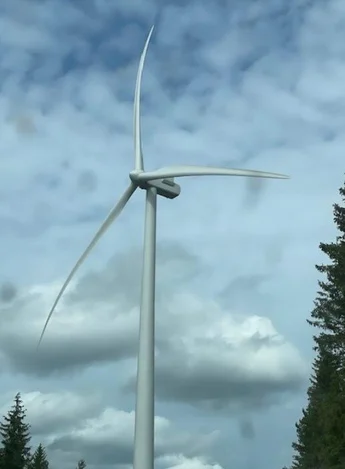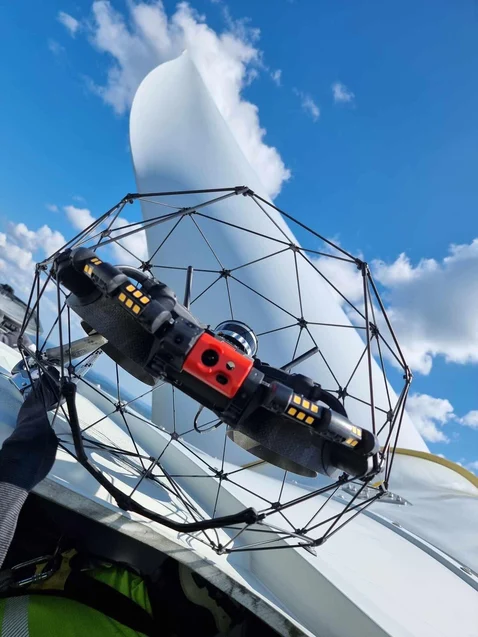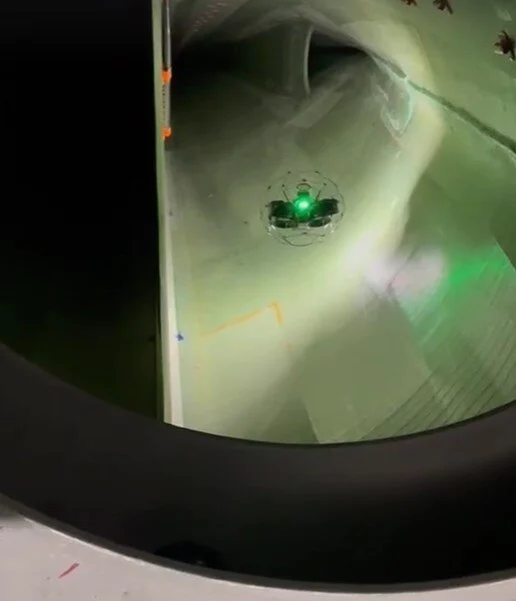Wind Turbine Blade Inspections with the Elios 3
Explore how the Elios 3 drone revolutionized wind turbine blade inspections, delivering results in just one day instead of five!
Key Benefits at a Glance
|
Safety Inspecting the inside of a wind turbine blade involves working at heights and in tight spaces. The Elios 3 reduces risks by eliminating the need for human entry into the blade, making it a safer option. |
Speed The Elios 3 completed a full blade inspection in just 27 minutes—far quicker than the 2 hours needed with a rover or up to 2 days using manual methods. It's clearly the fastest solution available. |
|
Data Quality Equipped with a 4K camera, the Elios 3 captured detailed images of lightning damage and past maintenance work along the blades. Its LiDAR point cloud also provided accurate navigation within the confined space. |
Access After launching from the hub, the Elios 3 could fly into each blade without needing repositioning. Its compact size allowed it to reach nearly the entire length of the blade, collecting essential data remotely. |
According to the Global Wind Energy Council, there are over 341,000 wind turbines worldwide. These towering structures are highly efficient, with an average turbine from 2020 generating enough power for a household for a month in just 46 minutes. However, maintaining these massive systems comes with significant challenges.
Wind turbines are located high above ground and often in cramped, hard-to-reach areas. To inspect them, workers require specialized training to navigate confined spaces safely. This makes finding qualified personnel difficult and costly. Traditional methods are not only slow but also risky.
Why Use Drones for Wind Turbine Inspections?
In February 2024, Swedish company Drone Solution partnered with a wind turbine management firm to test if drones could be used to inspect the inside of wind turbines. While they had already used drones for external inspections, this was the first time they attempted internal blade inspections. Drone Solution is among the few operators globally capable of performing such tasks.
 The sheer scale of wind turbines makes inspections extremely challenging.
The sheer scale of wind turbines makes inspections extremely challenging.
Blade inspections typically focus on identifying manufacturing faults or lightning damage. A lightning strike may leave only a small mark on the outside, but the internal structure could suffer serious damage. In some cases, a blade might even explode if the Lightning Protection System is faulty. Regular inspections help prevent these issues, especially since repairing a damaged blade can cost up to $1 million.
Drone Solution wanted to show that the Elios 3 could offer a faster, safer, and more effective way to inspect both the inside and outside of wind turbines. Their goal was to demonstrate how drones could streamline the entire inspection process.
Planning a Wind Turbine Blade Inspection with the Elios 3
Each wind turbine has three blades, all of which need to be inspected individually. Traditionally, this requires trained personnel to enter the blades, which are narrow and filled with internal structures like shear webs. Inspectors must rotate the blades to check both sides, making the process time-consuming and labor-intensive.
As a result, traditional blade inspections can take anywhere from 5 to 9 days, depending on the turbine’s size. Drone Solution aimed to prove that the Elios 3 could significantly speed up this process.
The Process: A Drone Wind Turbine Blade Inspection
The demonstration involved a turbine with 67-meter-long blades. Drone Solution’s team had previously undergone wind turbine training before arriving on-site. They took a 20-minute elevator ride to the hub, where they accessed the blades through hatches.
They programmed the turbine to pitch two blades upward, positioning them at angles similar to 10 and 2 o’clock on a clock. This ensured the drone would safely return to the hub in case of any issues.

The Elios 3 outside of an access hatch on a turbine
The Elios 3 was flown into each blade and navigated along the shear webs for 30 meters. The pilot used the 4K camera to capture visual data and identify potential issues, including lightning damage. The FlyAware LiDAR scan helped navigate the tight, dark space when the drone was out of sight.
The entire inspection was completed in 27 minutes across three flights. The process was repeated for all three blades. Afterward, a second drone was used to inspect the exterior of the turbine.

Snapshot: the Elios 3 flying inside a turbine blade with the shear web on the left
Results of the Drone Wind Turbine Blade Inspection
Both Drone Solution and their client were impressed by the results. The Elios 3 revealed internal damage that wasn’t visible from the outside, proving its effectiveness over traditional methods. This type of inspection usually requires two trained individuals, but the drone reduced the number of people needed to just one.
With the Elios 3, each blade could be inspected in under 30 minutes. Traditional methods, whether using a person or a rover, took much longer—up to a day per blade. This made the drone solution not only faster but also more cost-effective.
Thanks to the success of this trial, Drone Solution hopes to expand the use of drone inspections across more wind farms. This could become a regular and valuable mission for their team, offering a safer, faster, and more reliable alternative to traditional blade inspections.
Vacuum Lifter,glass lifter,glass Vacuum Lifter,glass lifting equipment,glass installation lifter,glass lifting
Guangdong Cowest Machinery Equipment Co.,ltd. , https://www.cowestmac.com